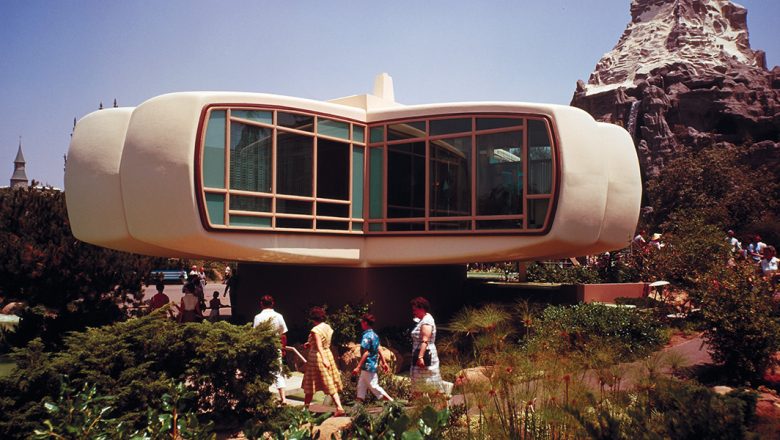By Gary Fleisher
For over seven decades, architects, designers, and technologists have been crafting visions of “Homes of the Future,” integrating cutting-edge technology, avant-garde design concepts, and innovative materials. These visionary projects aimed not just to predict, but to shape the evolution of residential living, offering a glimpse into how future generations might inhabit their spaces. While not all of these futuristic abodes have directly transformed the landscape of housing as their creators envisioned, their legacy is unmistakable in the blueprints of modern home design and construction.

Disney’s Home of the Future
The Dawn of Smart Home Technology
One of the most tangible legacies of these futuristic homes is the widespread adoption of smart home technology. Concepts that once seemed lifted from the pages of science fiction—automated systems controlling everything from temperature to security, and appliances managed remotely—are now commonplace. The genesis of this transformation can be traced back to those early prototypes of the future home, which imagined a world where technology seamlessly integrates into our living spaces, enhancing comfort, convenience, and efficiency. This vision has materialized in today’s smart thermostats, sophisticated security systems, and interconnected appliances, heralding a new era of home automation that was once only a dream.

Embracing Sustainability and Eco-Friendliness
Another cornerstone of the “Homes of the Future” was their emphasis on sustainability and environmental stewardship. These pioneering projects showcased solar panels, green roofs, and energy-efficient designs long before such features became a staple of eco-conscious architecture. Today, these elements are not just trendy; they’re essential components of new constructions, reflecting a collective shift towards more sustainable living practices. This transition underscores a broader societal recognition of the importance of minimizing our ecological footprint, a principle that was once a forward-looking feature of future homes.

The Rise of Modular and Prefabricated Homes
The concept of modular and prefabricated homes also owes a debt to the futuristic visions of the past. These designs promoted the idea of efficient, scalable construction, allowing homes to be assembled quickly and with less waste than traditional building methods. Advances in technology and materials have now made these concepts more viable and appealing than ever, with modern prefabricated homes offering a blend of design flexibility, efficiency, and sustainability. This shift towards modular construction reflects a broader trend in the housing industry towards innovation and adaptability, hallmarks of the “Homes of the Future.”

Innovative Materials and Construction Methods
The innovative use of materials and construction methods featured in futuristic home designs has had a profound influence on the building industry. These homes often utilized lightweight, durable materials and embraced techniques aimed at enhancing energy efficiency and structural integrity. Such innovations have gradually permeated mainstream construction, leading to buildings that are not only more sustainable but also capable of withstanding the challenges of a changing climate. This evolution in building practices underscores the lasting impact of future home concepts on modern construction, marrying aesthetic appeal with practical sustainability.

photo – autovol
The Evolutionary Impact on Housing
Despite their visionary allure, the “Homes of the Future” have had a more evolutionary than revolutionary impact on the housing market. Many of the ideas they introduced were technologically or economically ahead of their time, facing hurdles in widespread adoption. Yet, as technology has advanced and societal priorities have shifted, the housing industry has begun to weave these innovations into the fabric of contemporary design and construction. This gradual integration process highlights the dynamic nature of innovation in housing, where ideas once considered radical become part of the mainstream through continuous adaptation and refinement.

Inspiring the Future of Residential Design
Perhaps the most enduring success of the “Homes of the Future” lies in their ability to captivate the public imagination and push the boundaries of what is possible in residential design. These projects served as a beacon for architects, designers, and builders, inspiring them to explore new possibilities and challenge conventional wisdom. The legacy of these homes is not just in the specific technologies or design elements they introduced, but in the spirit of innovation and exploration they embodied. They remind us that the future of housing is not a fixed destination but a continuous journey of discovery and creativity.

Looking back on the legacy of the “Homes of the Future,” it’s clear that their impact extends far beyond the physical structures they proposed. They have shaped the trajectory of modern home design, influencing how we think about living spaces, technology, and our relationship with the environment. These visionary projects have laid the groundwork for a future where homes are not just places to live, but dynamic spaces that adapt to our needs, reflect our values, and enhance our quality of life.
In this sense, the journey into the future of housing is an ongoing adventure, one that continues to be inspired by the bold ideas and imaginative concepts of the past.
Gary Fleisher is a renowned blogger and commentator on construction and housing trends, known for his insightful analysis of the industry.



